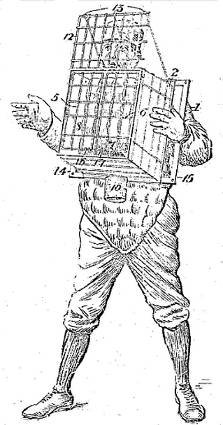
Illinois inventor James E. Bennett offered this contraption in 1904 to enable baseball catchers to intercept the ball without using their hands. The ball passes through the wire frame and hits a cushion at the rear of the box, then drops into a pocket from which the player can retrieve it.
It was not well received. The Cincinnati Enquirer said the box resembled “a cage built for a homesick bear or a dyspeptic hyena.”
Further, as Dan Gutman points out in his 1995 collection of baseball inventions, Banana Bats & Ding-Dong Balls, a catcher does more than catch pitches. “On a high pop, presumably, the catcher would have to run to the spot where he judged the ball was going to land, then lie on the ground face up and wait for it to hit him in the stomach.” At least his hands will be free.
